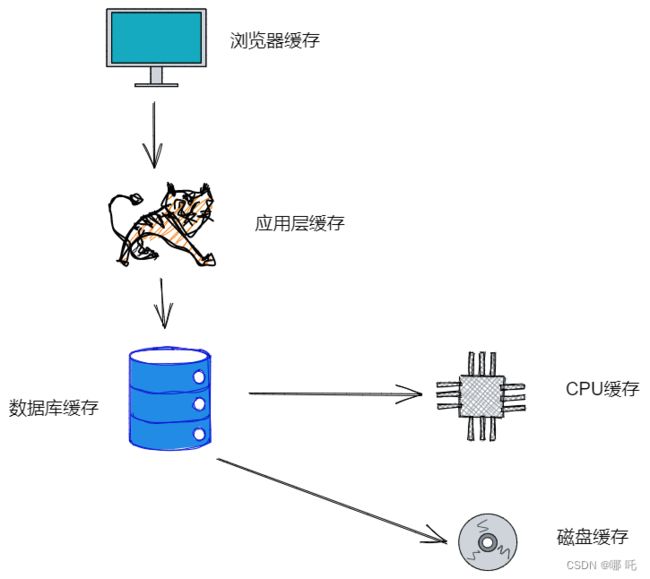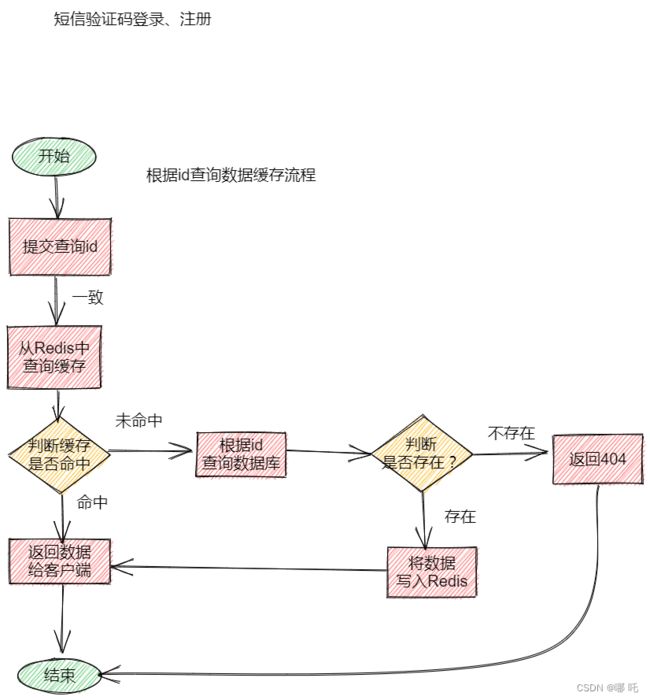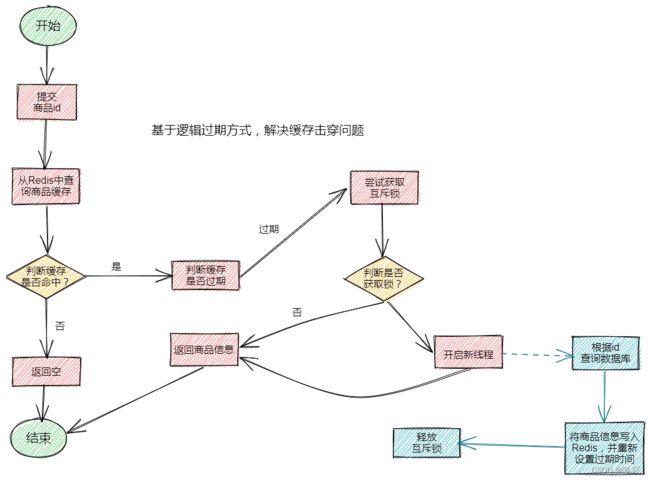Redis缓存穿透、击穿、雪崩到底是个啥?7张图告诉你
目录
-
- 一、缓存是什么?
- 二、缓存的作用和成本
-
- 1、缓存的作用:
- 2、缓存的成本:
- 三、缓存作用模型
-
- 1、根据id查询数据缓存流程
- 四、缓存更新策略
-
- 1、内存淘汰
- 2、超时剔除
- 3、主动更新
- 五、缓存穿透
-
- 解决方法:
- 六、缓存雪崩
- 七、缓存击穿
-
- 1、通过互斥锁解决缓存击穿
- 2、根据id查询商品信息,基于互斥锁解决缓存击穿问题
- 3、通过逻辑过期解决缓存击穿
- 八、Redis工具类
-
- NoSQL数据库进阶实战
- 哪吒精品系列文章
一、缓存是什么?
缓存就是数据交换的缓存区,是存储数据的地方,一般读写性能较高。

二、缓存的作用和成本
1、缓存的作用:
- 降低后端负载
- 提高读写效率,降低响应时间
2、缓存的成本:
- 数据一致性成本
- 代码维护成本
- 运维成本
三、缓存作用模型
1、根据id查询数据缓存流程
四、缓存更新策略
1、内存淘汰
Redis的内存淘汰机制,当内存不足时自动淘汰部分数据,下次查询时更新缓存。
2、超时剔除
当缓存数据设置TTL时间,到期后自动删除缓存,下次查询时更新缓存。
3、主动更新
编写业务逻辑,在修改数据库的同时,更新缓存。
五、缓存穿透
缓存穿透是指客户端请求的数据在Redis和数据库中都不存在,这样就无法进行缓存,这些请求都会打到数据库。
解决方法:
1、缓存空对象
对不存在的数据也在Redis中建立缓存,值为空,并设置一个较短的TTL时间。
- 优点:实现简单,维护方便;
- 缺点:额外的内存消耗,可能造成短期的数据不一致;
2、布隆过滤器
利用布隆过滤算法,在请求进入Redis之前,先判断是否存在,如果不存在则直接拒绝访问。
- 优点:内存占用小
- 缺点:① 实现复杂;② 存在误判的可能;
六、缓存雪崩
缓存雪崩是指同一时间段大量的缓存key同时失效或者Redis服务宕机,导致大量请求打到数据库,带来巨大压力。
解决方式:
- 给不同的key的TTL添加随机值;
- 利用Redis集群提高服务的可用性;
- 给缓存添加降级限流策略;
- 给业务添加多级缓存;
七、缓存击穿
缓存击穿也叫热点key问题,就是一个被高并发访问并且缓存重建业务较复杂的key失效了,无数的请求访问会在瞬间打到数据库,带来巨大压力。
1、通过互斥锁解决缓存击穿
给缓存重建过程加锁,确保重建过程只有一个线程执行,其它线程等待。
2、根据id查询商品信息,基于互斥锁解决缓存击穿问题
3、通过逻辑过期解决缓存击穿
逻辑过期的优点是性能好,缺点是不保证一致性,有额外的内存消耗,实现复杂。

八、Redis工具类
// 解决缓存穿透
Goods goods = cacheClient.queryWithPassThrough(CACHE_GOODS_KEY, id, Goods.class, this::getById, CACHE_GOODS_TTL, TimeUnit.MINUTES);
// 互斥锁解决缓存击穿
Goods goods = cacheClient.queryWithMutex(CACHE_GOODS_KEY, id, Goods.class, this::getById, CACHE_GOODS_TTL, TimeUnit.MINUTES);
// 逻辑过期解决缓存击穿
Goods goods = cacheClient.queryWithLogicalExpire(CACHE_GOODS_KEY, id, Goods.class, this::getById, 20L, TimeUnit.SECONDS);
package com.guor.utils;
import cn.hutool.core.util.BooleanUtil;
import cn.hutool.core.util.StrUtil;
import cn.hutool.json.JSONObject;
import cn.hutool.json.JSONUtil;
import lombok.extern.slf4j.Slf4j;
import org.springframework.data.redis.core.StringRedisTemplate;
import org.springframework.stereotype.Component;
import java.time.LocalDateTime;
import java.util.concurrent.ExecutorService;
import java.util.concurrent.Executors;
import java.util.concurrent.TimeUnit;
import java.util.function.Function;
@Slf4j
@Component
public class CacheClient {
private final StringRedisTemplate stringRedisTemplate;
private static final ExecutorService CACHE_REBUILD_EXECUTOR = Executors.newFixedThreadPool(10);
public CacheClient(StringRedisTemplate stringRedisTemplate) {
this.stringRedisTemplate = stringRedisTemplate;
}
public void set(String key, Object value, Long time, TimeUnit unit) {
stringRedisTemplate.opsForValue().set(key, JSONUtil.toJsonStr(value), time, unit);
}
public void setWithLogicalExpire(String key, Object value, Long time, TimeUnit unit) {
// 设置逻辑过期
RedisData redisData = new RedisData();
redisData.setData(value);
redisData.setExpireTime(LocalDateTime.now().plusSeconds(unit.toSeconds(time)));
// 写入Redis
stringRedisTemplate.opsForValue().set(key, JSONUtil.toJsonStr(redisData));
}
public <R,ID> R queryWithPassThrough(String keyPrefix, ID id, Class<R> type, Function<ID, R> dbFallback, Long time, TimeUnit unit){
String key = keyPrefix + id;
// 1.从redis查询商铺缓存
String json = stringRedisTemplate.opsForValue().get(key);
// 2.判断是否存在
if (StrUtil.isNotBlank(json)) {
// 3.存在,直接返回
return JSONUtil.toBean(json, type);
}
// 判断命中的是否是空值
if (json != null) {
// 返回一个错误信息
return null;
}
// 4.不存在,根据id查询数据库
R r = dbFallback.apply(id);
// 5.不存在,返回错误
if (r == null) {
// 将空值写入redis
stringRedisTemplate.opsForValue().set(key, "", RedisConfig.CACHE_NULL_TTL, TimeUnit.MINUTES);
// 返回错误信息
return null;
}
// 6.存在,写入redis
this.set(key, r, time, unit);
return r;
}
public <R, ID> R queryWithLogicalExpire(String keyPrefix, ID id, Class<R> type, Function<ID, R> dbFallback, Long time, TimeUnit unit) {
String key = keyPrefix + id;
// 1.从redis查询商铺缓存
String json = stringRedisTemplate.opsForValue().get(key);
// 2.判断是否存在
if (StrUtil.isBlank(json)) {
// 3.存在,直接返回
return null;
}
// 4.命中,需要先把json反序列化为对象
RedisData redisData = JSONUtil.toBean(json, RedisData.class);
R r = JSONUtil.toBean((JSONObject) redisData.getData(), type);
LocalDateTime expireTime = redisData.getExpireTime();
// 5.判断是否过期
if(expireTime.isAfter(LocalDateTime.now())) {
// 5.1.未过期,直接返回店铺信息
return r;
}
// 5.2.已过期,需要缓存重建
// 6.缓存重建
// 6.1.获取互斥锁
String lockKey = RedisConfig.LOCK_GOODS_KEY + id;
boolean isLock = tryLock(lockKey);
// 6.2.判断是否获取锁成功
if (isLock){
// 6.3.成功,开启独立线程,实现缓存重建
CACHE_REBUILD_EXECUTOR.submit(() -> {
try {
// 查询数据库
R newR = dbFallback.apply(id);
// 重建缓存
this.setWithLogicalExpire(key, newR, time, unit);
} catch (Exception e) {
throw new RuntimeException(e);
}finally {
// 释放锁
unlock(lockKey);
}
});
}
// 6.4.返回过期的商铺信息
return r;
}
public <R, ID> R queryWithMutex(String keyPrefix, ID id, Class<R> type, Function<ID, R> dbFallback, Long time, TimeUnit unit) {
String key = keyPrefix + id;
// 1.从redis查询商铺缓存
String json = stringRedisTemplate.opsForValue().get(key);
// 2.判断是否存在
if (StrUtil.isNotBlank(json)) {
// 3.存在,直接返回
return JSONUtil.toBean(json, type);
}
// 判断命中的是否是空值
if (json != null) {
// 返回一个错误信息
return null;
}
// 4.实现缓存重建
// 4.1.获取互斥锁
String lockKey = RedisConfig.LOCK_GOODS_KEY + id;
R r = null;
try {
boolean isLock = tryLock(lockKey);
// 4.2.判断是否获取成功
if (!isLock) {
// 4.3.获取锁失败,休眠并重试
Thread.sleep(50);
return queryWithMutex(keyPrefix, id, type, dbFallback, time, unit);
}
// 4.4.获取锁成功,根据id查询数据库
r = dbFallback.apply(id);
// 5.不存在,返回错误
if (r == null) {
// 将空值写入redis
stringRedisTemplate.opsForValue().set(key, "", RedisConfig.CACHE_NULL_TTL, TimeUnit.MINUTES);
// 返回错误信息
return null;
}
// 6.存在,写入redis
this.set(key, r, time, unit);
} catch (InterruptedException e) {
throw new RuntimeException(e);
}finally {
// 7.释放锁
unlock(lockKey);
}
// 8.返回
return r;
}
private boolean tryLock(String key) {
Boolean flag = stringRedisTemplate.opsForValue().setIfAbsent(key, "1", 10, TimeUnit.SECONDS);
return BooleanUtil.isTrue(flag);
}
private void unlock(String key) {
stringRedisTemplate.delete(key);
}
}
NoSQL数据库进阶实战
NoSQL数据库进阶实战1,那些年学过的NoSQL基础
NoSQL数据库进阶实战2,NoSQL数据存储模式
哪吒精品系列文章
Java学习路线总结,搬砖工逆袭Java架构师
10万字208道Java经典面试题总结(附答案)
Java基础教程系列
Java高并发编程系列
数据库进阶实战系列
![]()




